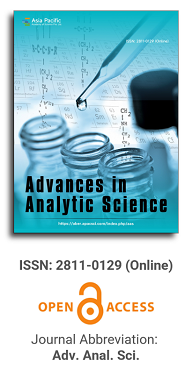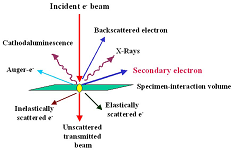
Asia Pacific Academy of Science Pte. Ltd. (APACSCI) specializes in international journal publishing. APACSCI adopts the open access publishing model and provides an important communication bridge for academic groups whose interest fields include engineering, technology, medicine, computer, mathematics, agriculture and forestry, and environment.

Research progress in cultural relic material analysis based on portable hyperspectral instrument
Vol 6, Issue 1, 2025
Download PDF
Abstract
Cultural relics carry splendid civilizations, inherit historical culture, and are precious heritage of all mankind. Due to the preciousness of cultural relics, which are non-renewable, and the basic principle of cultural relic protection with minimal intervention, non-destructive analysis technology has always been the most important technical means of material analysis in the research of cultural relic production technology, deterioration mechanism, and protection and restoration. Therefore, the research and development and application of new non-destructive analysis technology is an important research direction for the protection and utilization of cultural relics. In recent years, portable hyperspectral spectrometers originated from the field of remote sensing have shown great application potential in the analysis of cultural relic materials, and have been successfully applied in the restoration of cultural relics such as stone ancient buildings and paintings. As a non-invasive spectral technology that does not require sampling, the portable hyperspectral instrument can obtain a full-band, high-resolution reflectance spectrum covering the visible light-near infrared-shortwave infrared band (350–2500 nm) in a very short time. At the same time, it is highly portable and has no special requirements for the working environment, light source, etc. It can be used in situ at the site of field cultural relics or ruins. In addition, while collecting spectral data, remote sensing technology can also be used to achieve remote transmission and analysis of data. The above technical characteristics give it unique application advantages in the analysis of cultural relics materials. Based on the basic principles of spectral technology, this paper first introduces the equipment models and performance indicators of portable ground feature hyperspectral instruments commonly used in the analysis of cultural relics materials. Secondly, it carefully sorts out its application status in the qualitative and quantitative analysis of organic/inorganic cultural relics materials, analysis of cultural relics protection materials, and in-situ and real-time monitoring of cultural relics restoration in the past decade. After that, it discusses in depth the two key issues that affect the application effect of this technology, namely the specification of spectral preprocessing and the establishment of a standard spectral library. Finally, it looks forward to the development trend of this technology, and it is expected to have broad prospects in the analysis of fragile organic cultural relics, the combined application of multiple analysis techniques and quantitative analysis research.
Keywords
References
1. Tejedor B, Lucchi E, Bienvenido-Huertas D, et al. Non-destructive techniques (NDT) for the diagnosis of heritage buildings: Traditional procedures and futures perspectives. Energy and Buildings. 2022; 263: 112029. doi: 10.1016/j.enbuild.2022.112029
2. Camaiti M, Benvenuti M, Costagliola P, et al. Hyperspectral sensors for the characterization of cultural heritage surfaces. In: Masini N, Soldovieri F (editors). Sensing the Past: From Artifact to Historical Site. Springer, Cham; 2017. pp. 289–311. doi: 10.1007/978-3-319-50518-3_13
3. Ricciardi P. UV-visible-near IR reflectance spectrophotometry in a museum environment. In: Adriaens M, Dowsett M (editors). Spectroscopy, Diffraction and Tomography in Art and Heritage Science. Elsevier; 2021. pp. 103–131. doi: 10.1016/B978-0-12-818860-6.00003-9
4. Liang H. Advances in multispectral and hyperspectral imaging for archaeology and art conservation. Applied Physics A. 2012; 106: 309–323. doi: 10.1007/s00339-011-6689-1
5. Deng B, Guo H, Wang C, et al. Applications of remote sensing technique in archaeology: A review (Chinese). National Remote Sensing Bulletin. 2010; 14(1): 187–206. doi: 10.11834/jrs.20100115
6. Camaiti M, Vettori S, Benvenuti M, et al. Hyperspectral sensor for gypsum detection on monumental buildings. Journal of Geophysics and Engineering. 2011; 8(3): S126–S131. doi: 10.1088/1742-2132/8/3/S12
7. Clark R. Spectroscopy of rocks and minerals and principles of spectroscopy. In: Rencz AN, Ryerson RA (editors). Remote Sensing for the Earth Sciences, 3rd Edition. John Wiley & Sons, Inc.; 1999.
8. Ramakrishnan D, Bharti R. Hyperspectral remote sensing and geological applications. Current Science. 2015; 108(5): 879–891.
9. Workman J Jr., Weyer L. Practical Guide to Interpretive Near-Infrared Spectroscopy, 1st Edition. CRC Press; 2007. doi: 10.1201/9781420018318
10. Beć KB. A simple guide to complex world of overtone and combination bands: Theoretical simulation and interpretation of NIR spectra–summary of the workshop at NIR-2021 Beijing Conference. NIR News. 2021; 32(7–8): 15–18. doi: 10.1177/09603360211060966
11. Goetz AF, Vane G, Solomon JE, et al. Imaging spectrometry for Earth remote sensing. Science. 1985; 228(4704): 1147–1153. doi: 10.1126/science.228.4704.1147
12. Cucci C, Delaney JK, Picollo M. Reflectance hyperspectral imaging for investigation of works of art: Old master paintings and illuminated manuscripts. Accounts of Chemical Research. 2016; 49(10): 2070–2079. doi: 10.1021/acs.accounts.6b00048
13. Picollo M, Cucci C, Casini A, et al. Hyper-spectral imaging technique in the cultural heritage field: New possible scenarios. Sensors. 2020; 20(10): 2843. doi: 10.3390/s20102843
14. Cucci C, Casini A. Hyperspectral imaging for artworks investigation. In: Data Handling in Science and Technology: Hyperspectral Imaging. Elsevier; 2019. pp. 583–604. doi: 10.1016/B978-0-444-63977-6.00023-7
15. Gao Z, Du M, Cao N, et al. Application of hyperspectral imaging technology to digitally protect murals in the Qutan temple. npj Heritage Science. 2023; 11: 8. doi: 10.1186/s40494-022-00847-7
16. Lin W, Peng Y, Wang C. Design of portable device for rapid nondestructive detection of fresh meat quality (Chinese). Transactions of the Chinese Society of Agricultural Engineering. 2014; 30(7): 243–249. doi: 10.3969/j.issn.1002-6819.2014.07.029
17. O’Brien NA, Hulse CA, Friedrich DM, et al. Miniature near-infrared (NIR) spectrometer engine for handheld applications. Proceedings of SPIE. 2012; 8374: 837404. doi: 10.1117/12.917983
18. Catelli E, Sciutto G, Prati S, et al. A new miniaturised short-wave infrared (SWIR) spectrometer for on-site cultural heritage investigations. TALANTA. 2020; 218: 121112–121121. doi: 10.1016/j.talanta.2020.121112
19. Wang C, Tie F, Zhao X, et al. Preliminary study on the non-invasive characterization of organic binding media employing a portable hyperspectral sensor (Chinese). Spectroscopy and Spectral Analysis. 2021; 41(9): 2886. doi: 10.3964/j.issn.1000-0593(2021)09-2886-06
20. Campbell JB, Wynne RH. Introduction to Remote Sensing, 5th Edition. The Guilford Press; 2011.
21. Suzuki A, Vettori S, Giorgi S, et al. Laboratory study of the sulfation of carbonate stones through SWIR hyperspectral investigation. Journal of Cultural Heritage. 2018; 32: 30–37. doi: 10.1016/j.culher.2018.01.006
22. Gaffey SJ. Spectral reflectance of carbonate minerals in the visible and near infrared (0.35-2.55 microns); calcite, aragonite, and dolomite. American Mineralogist. 1986; 71(1-2): 151–162.
23. Cimino D, Falchi L, Corradini M, et al. Reflectance spectroscopy as a non-invasive technique for preliminary characterization of soluble salts on historical masonries. In: Osman A, Moropoulou A (editors). Advanced Nondestructive and Structural Techniques for Diagnosis, Redesign and Health Monitoring for the Preservation of Cultural Heritage. Springer, Cham; 2022. pp. 28–34. doi: 10.1007/978-3-031-03795-5_4
24. Aceto M, Agostino A, Fenoglio G, et al. Characterisation of colourants on illuminated manuscripts by portable fibre optic UV-visible-NIR reflectance spectrophotometry. Analytical Methods. 2014; 6: 1488–1500. doi: 10.1039/C3AY41904E
25. Horn KR, Walker G, Winton V, et al. Field characterisation of rock art paintings using non-invasive reflectance spectroscopy in the search for organic paint binders at Genealogy and Stickman Rockshelters in the Weld Range (Western Australia). Journal of Archaeological Science: Reports. 2020; 34: 102617. doi: 10.1016/j.jasrep.2020.102617
26. Perino M, Pronti L, Di Forti LG, et al. Revealing artists’ collaboration in a 14th century manuscript by non-invasive analyses. Minerals. 2021; 11(7): 771. doi: 10.3390/min11070771
27. Radpour R, Delaney JK, Kakoulli I. Acquisition of high spectral resolution diffuse reflectance image cubes (350–2500 nm) from archaeological wall paintings and other immovable heritage using a field-deployable spatial scanning reflectance spectrometry hyperspectral system. Sensors. 2022; 22(5): 1915. doi: 10.3390/s22051915
28. Liu W, Li M. Wu N, et al. A new application of Fiber optics reflection spectroscopy (FORS): Identification of “bronze disease” induced corrosion products on ancient bronzes. Journal of Cultural Heritage. 2021. 49: 19–27. doi: 10.1016/j.culher.2021.03.007
29. Pallipurath AR, Skelton JM, Ricciardi P, et al. Estimation of semiconductor-like pigment concentrations in paint mixtures and their differentiation from paint layers using first-derivative reflectance spectra. Talanta. 2016; 154: 63–72. doi: 10.1016/j.talanta.2016.03.052
30. Lyu S, Liu Y, Hou M, et al. Quantitative analysis of mixed pigments for Chinese paintings using the improved method of ratio spectra derivative spectrophotometry based on mode. Heritage Science. 2020; 8: 31. doi: 10.1186/s40494-020-00372-5
31. Ricciardi P, Delaney JK, Facini M, et al. Near infrared reflectance imaging spectroscopy to map paint binders in situ on illuminated manuscripts. Angewandte Chemie (International Edition) 2012; 51(23): 5607–5610. doi: 10.1002/anie.201200840
32. Dooley KA, Lomax S, Zeibel JG, et al. Mapping of egg yolk and animal skin glue paint binders in Early Renaissance paintings using near infrared reflectance imaging spectroscopy. Analyst. 2013; 138: 4838–4848. doi: 10.1039/C3AN00926B
33. Gabrieli F, Dooley KA, Facini M, et al. Near-UV to mid-IR reflectance imaging spectroscopy of paintings on the macroscale. Science Advances. 2019; 5(8): eaaw7794. doi: 10.1126/sciadv.aaw7794
34. Pallipurath A, Skelton J, Ricciardi P, et al. Multivariate analysis of combined Raman and fibre-optic reflectance spectra for the identification of binder materials in simulated medieval paints. Journal of Raman Spectroscopy. 2013; 44(6): 866–874. doi: 10.1002/jrs.4291
35. Wang C, Salvatici T, Camaiti M, et al. A new application of hyperspectral radiometry: the characterization of painted surfaces. EGU General Assembly. 2016; 18: 18255.
36. Horn KR. Time takes its toll: Detection of organic binder media in ochre paints with visible near-infrared and short-wave infrared reflectance spectroscopy. Journal of Archaeological Science: Reports. 2018; 21: 10–20. doi: 10.1016/j.jasrep.2018.06.033
37. Amato SR, Burnstock A, Michelin A. A preliminary study on the differentiation of linseed and poppy oil using principal component analysis methods applied to fiber optics reflectance spectroscopy and diffuse reflectance imaging spectroscopy. Sensors. 2020; 20(24): 7125. doi: 10.3390/s20247125
38. Zhao H, Wang Y, Liu S, et al. Spectral reflectance characterization and fiber type discrimination for common natural textile materials using a portable spectroradiometer. Journal of Archaeological Science. 2018; 111: 105026. doi: 10.1016/j.jas.2019.105026
39. Ding L, Gong T, Yang Q, et al. Non-destructive fiber type identification in ancient textiles using portable near- infrared fiber optic reflectance spectroscopy (Chinese). Science of Conservation and Archaeology. 2021; 33(4): 128–136.
40. Vettori S, Pecchioni E, Camaiti M, et al. Portable hyperspectral device as a valuable tool for the detection of protective agents applied on hystorical buildings. EGU General Assembly. 2012; 14: 9459.
41. Wang C, Cao Y, Tie F, et al. Er:YAG laser cleaning of painted surfaces: Functional considerations to improve efficacy and reduce side effects. Coatings. 2021; 11(11): 1315. doi: 10.3390/coatings11111315
42. Vettori S, Verrucchi M, Di Benedetto F, et al. Hyperspectral sensor: A handy tool to evaluate the efficacy of cleaning procedures. Journal of Cultural Heritage. 2021; 49: 79–84. doi: 10.1016/j.culher.2021.02.012
43. Maynez-Rojas MA, Casanova-González E, Ruvalcaba-Sil JL. Identification of natural red and purple dyes on textiles by Fiber-optics Reflectance Spectroscopy. Spectrochimica Acta. Part A, Molecular and Biomolecular Spectroscopy. 2017; 178: 239–250. doi: 10.1016/j.saa.2017.02.019
44. Pottier F, Kwimang S, Michelin A, et al. Independent macroscopic chemical mappings of cultural heritage materials with reflectance imaging spectroscopy: case study of a 16th century Aztec manuscript. Analytical Methods. 2017; 9(42): 5997–6008. doi: 10.1039/C7AY00749C
45. Zhang C, Hu Y, Hou M, et al. Pigment identification of colored relics based on improved spectral absorption feature fitting algorithm (Chinese). Journal of Spatio-Temporal Information. 2017; 24(3): 119–123. doi: 10.3969/j.issn.1672-1586.2017.03.023
Supporting Agencies
Copyright (c) 2025 Cong Wang, Mara Camaiti, Daiyun Liu, Fude Tie, Yijian Cao

This work is licensed under a Creative Commons Attribution 4.0 International License.

This site is licensed under a Creative Commons Attribution 4.0 International License (CC BY 4.0).
1.jpg)
Prof. Sivanesan Subramanian
Anna University, India





.jpg)
